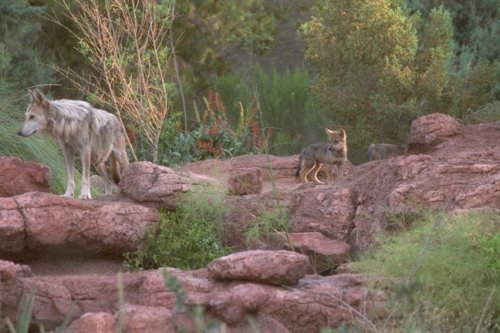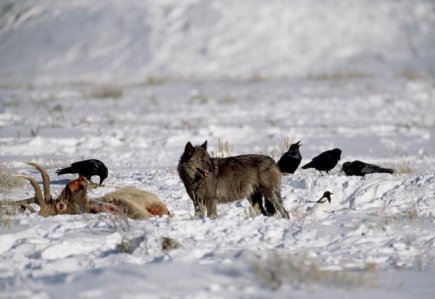In the Press: Efforts In San Diego Help Restore Critically Endangered Wolf
 By Katie Euphrat, Susan Murphy
By Katie Euphrat, Susan Murphy
A vibrant chorus cascades down the mountainside near Julian. The talented vocalists are gray wolves. They roam in a 50-acre conservation and research facility known as the California Wolf Center, founded in 1977 to educate the public about wildlife and ecology … .
“Here at the center we have 23 wolves,” said Erin Hunt, general manager of the California Wolf Center. “We have six Alaskan gray wolves, and the Alaskan gray wolves are here for education and research purposes. We also house Mexican gray wolves, which are critically endangered, with only about 50 living in the wild today.”
Once on the brink of extinction, Mexican gray wolves are staging a comeback. A conservation center in San Diego is helping with the effort to reintroduce them to the wild.
Mexican gray wolves were nearly extinct in the 1970s, with just five remaining in the wild. But the survivors were captured and the species was saved. Today, the Wolf Center is part of a national effort to give them a second chance.
“We have had one pack of wolves born here actually get to go out into the wild and they lived successfully in the wild for many years,” said Hunt. “And the alpha female of that pack has offspring that are still currently living in the wild.”
Three more wolves are set to be released this fall or winter to the reintroduction area along the Arizona and New Mexico border.
The wolves preparing to be reintroduced have very limited human contact. Most of the packs are off display and kept far away from visitors.
“We limit the amount of time we spend in each enclosure,” said Hunt, “and we only enter certain areas of the enclosure. You don’t want to release a wolf that’s gotten a little too used to being around people by being in the captive environment,” Hunt explained.
Hunt said the wolves thrive at the center — four pups were born in April. But when they’re released into the wild they face many challenges.
“That’s when the work really begins,” said Chelsea Davis, the Center’s animal care and facilities manager. “The wolves in the wild are monitored and checked weekly.”
One way they’re monitored is through howl surveys. “So they’ll go out around dawn or dusk — peak activity times for wolves,” said Davis. “And they’ll actually try to get wolf packs to howl — and you can tell two individuals and two pups.”
Another way is through special micro-chipped collars.
“A lot of times you’re expecting the wolves will stay in the area where you released them and then you find them 60 miles away from there by the end of the week,” said Davis.
The wolves are also observed to make sure they’re hunting and eating the right prey, such as elk, deer and fish. That’s because the reintroduction area is federal grazing land where roaming cattle and sheep often become tasty temptations.
Historically, wolves were killed by ranchers for attacking livestock. At the Wolf Center, researchers are experimenting with taste aversion, which is lacing meat with a nausea-inducing chemical.
Dan Moriarty, a professor of psychological sciences at the University of San Diego is using the technique to teach captive Mexican gray wolves that eating sheep will make them sick.
“Some people describe this as a process of going from yum to yuck,” he said. “It tasted good when you first encountered it, but after this illness episode it simply doesn’t taste good anymore.
Moriarty said the question is whether the learned aversion during captivity will be enough to prevent the wolves from attacking livestock in the wild. … The real answer is going to come with the field trials, Moriarty added. …
 The goal is to create a thriving ecosystem —just like their sister, the Alaskan gray wolf has done in the northern Rockies. They too were on the brink of extinction and were reintroduced in the wild starting in 1995.
The goal is to create a thriving ecosystem —just like their sister, the Alaskan gray wolf has done in the northern Rockies. They too were on the brink of extinction and were reintroduced in the wild starting in 1995.
“So in Yellowstone national park when wolves returned, they kept the elk herds on the move. This prevented overgrazing which allowed willow and aspen trees to return and thrive. With the return of the willow and aspen, we saw a decrease of erosion in the stream beds in the river ecosystems in the park, which meant that song birds, fish, amphibians beavers and all sorts of other life could return to those areas,” said Hunt.
That’s why there’s such excitement over four Mexican gray wolf pups born at the center earlier this year. Hunt said they’ll likely be selected for breeding or release.
“It could take several years for that to happen,” said Hunt. “As I said they are very young animals right now, but it is definitely a potential in their future.”
Conservationists had hoped to have 100 Mexican gray wolves in the wild by 2005, but six years later, they’re only half way there.
**********************************************************************************************************************************************
To read the full article, post a comment and view pictures and video, click here.



